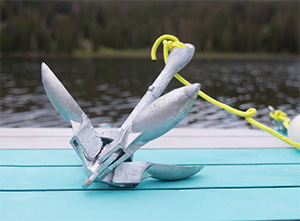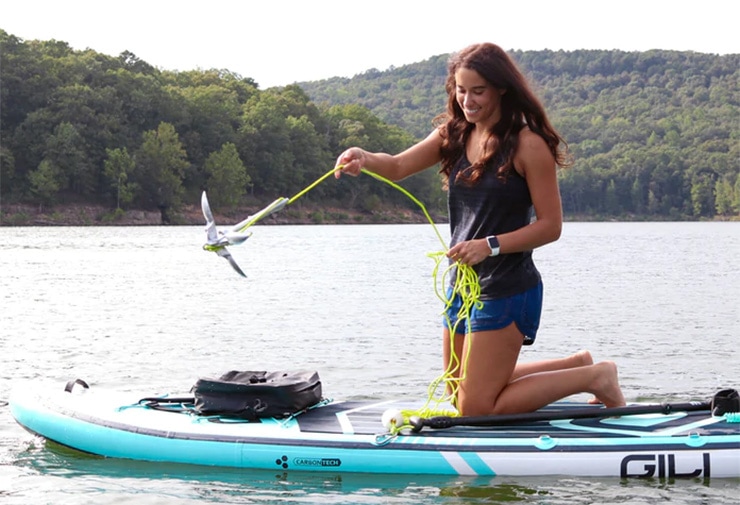Anchoring your paddle board for SUP yoga practice is much the same as anchoring any other small vessel. Simply find the right anchor, install it on your board, and use it when you need to.
Today, I’ll go over the details of how to attach your paddle board anchor and how to throw it overboard correctly, so that you can enjoy your time on the water.
I’ll also go over the different types of paddle board anchors you can expect to find when you’re shopping around.
RELATED: The Best Yoga SUP Boards Reviewed – Pros and Cons of Each
Why Use an Anchor for Paddle Board Yoga?
The biggest benefit of anchoring your paddle board during your SUP yoga routines to ensure you and your SUP remain stationary, so you don’t drift around on the water.
Even if you’re not actively paddling, the wind and the waves will gently push your paddle board around over time, and you may float further away from your starting point without realising. If you anchor your boat, you don’t have to deal with drifting.
If you are taking part in SUP yoga classes, it’s especially important to consider anchoring your board. This will keep you from drifting away from your class and from bumping into other paddlers.
Anchoring Your Paddle Board for Yoga is Easy

If you’ve never anchored your paddle board before (whether for paddle board yoga or not) you might be wondering how do you even start. While it can feel complicated, it’s actually easier than it seems.
You’ll need to start by examining your board for an anchor attachment. This hook or attachment will be at the tail end of your paddle board.
Step 1: Clip It onto the Board
Start by clipping your anchor onto your board. I like to use a carabiner hook to attach my anchor. These hooks are made out of aluminum (so they won’t rust) are super strong and are easy to hook and unhook.
Step 2: Unravel Your Anchor
Once your anchor is clipped on, it’s time to unravel it. If you have an anchor with hooks, release these hooks so that your anchor is ready to go. Before you throw your anchor overboard, make sure to unravel the rope so that you don’t have to deal with any knots.
Step 3: Throw Your Anchor Overboard
Now that your anchor is set up, it’s time to put it into the water. You never want to outright throw your anchor in the water. Doing so could hurt someone around you and it can throw you off balance.
Instead, allow your anchor to gently fall into the water. Feeding the anchor down will give you a sense of how deep the water is. It will also give you a sense of whether or not there are any rocks or vegetation down below.
Keep in mind that if the water is rather shallow, you may not end up using all your anchor line. Any extra rope can be tied to the end of your board.
Step 4: Pulling your Anchor Back Up
When it’s time to wrap up your SUP yoga routine, pulling your anchor backup is just as simple and straightforward. If you are anchored in a spot with lots of rocks and vegetation, you may need to wiggle your anchor out of its position. Otherwise, slowly pull your anchor up, fold it, wrap your line, and store it back and its storage bag.
How Heavy is A Paddle Board Anchor for Yoga?
The general rule of thumb is that for every 100 pounds of paddle board weight, you’ll need half a pound of anchor to help keep your board in place.
This includes the weight of the board as well as the weight of passengers and gear onboard. So for example, if the combined weight of you and your board is 200 pounds, then a 2 pound anchor is the absolute minimum weight your anchor should be.
Paddle board anchors generally range anywhere from five to 10 pounds. Depending on how much rope you use along with your anchor could make the whole unit way a pound or two heavier.
Still, anchors are relatively lightweight and do not make a huge difference in your paddle boarding experience when you’re not don’t have it reeled out.
ALSO READ: Discover the Top 10 Paddle Boarding and Yoga Retreats Worth Booking
Picking the Right Type of Paddle Board Anchor
Once you’ve determined the size of anchor you need, you next need todecide which type. There are many anchors to choose from, and the type of anchor system you use for paddle board yoga can depend on where you’ll be practicing, and the conditions of the water.
With the abundance of choices, it can be a little tricky to figure out which one to settle on.
Grapnel Anchor
Sometimes know nas a ‘grappling anchor’, this type of anchor is the most common. It features four prongs that fold out of the anchor’s center when you’re ready to use it. These prongs can be sharp so it’s important to be careful with them especially if you’re on an inflatable.
The great thing about this type of anchor is that the prongs do a really good job of hooking on to a rocky or sandy bottom. They are easy to assemble, use, and then pack away.
Sandbag Anchor
As the name suggests, a sandbag anchor is a durable bag that is filled with sand. Once you throw the sandbag overboard, its weight will hold your paddle board in place. Unlike a grapnel anchor, however, you may drift about because the sandbag doesn’t grab on to anything.
Corkscrew Anchor
A corkscrew anchor requires you to screw it into the ground manually in order to keep your board in place. Corkscrew anchors are good when you want to remain close to the shoreline or riverbank, as they have to be affixed to dry land and not the water bottom, but be warned – you likely won’t be able to reach deeper water as you’ll be tied to the shore.
Mushroom Anchor
A mushroom anchor is a mushroom or bell shaped weight with a smooth and rounded bottom. It’s less likely to scratch your paddle board during transport as a result of this, but it won’t easily snag in weeds or rocky bottoms like a grapnel anchor might. However it can be a good option for SUP yoga in the right environment.
YOU MAY ALSO LIKE: What’s the quickest way to learn SUP yoga?
Final Thoughts
SUP yoga is an incredibly enjoyable experience. However, one of the most overlooked mistakes newbies make is not bringing along an anchor for their board.
While you don’t necessarily have to anchor your board in order to have an enjoyable time out on the water, having a stationary board allows you to focus more on your yoga routine and less on whether or not you’re drifting away.

